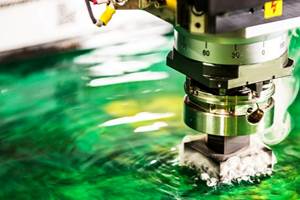Cost-Cutting Coolant Quells Odor, Dermatitis
Switching to Dyna Cool K2002, a semi-synthetic metalworking fluid, eliminated this shop’s difficulties with coolant odor, short sump life and dermatitis.
Share





"Monday morning odor"—a phrase commonly used to describe one result of rancid coolant—can make any shop a difficult environment in which to work. However, a revolting smell is likely the least of a shop’s worries, as coolant problems can significantly impact the bottom line. Coolant that tends to spoil due to microbial growth typically needs frequent replacement, adding to costs. Other common problems include dermatitis outbreaks among workers, rusted machine components, decreased tool life and poor surface finish.
Contract manufacturer Century Tool once struggled with these issues. Despite various concentration adjustments and the use of skimmers to remove tramp oil, sump life remained short and employees continued to experience bouts of dermatitis. The shop switched coolants entirely—twice—before finding the solution that it still uses today, more than 8 years after the initial implementation. Dyna Cool K2002, available from Dyna Tech Chemical Specialties (Pewaukee, Wisconsin), not only solved problems with sump life and dermatitis, but also improved tool life.
Century Tool’s 36 employees work out of a 34,000-square-foot facility in Rogers, Minnesota. Founded in 1968, the company provides CNC machining and turning, fabricating and assembly services to the defense, medical, food, robotics and other industries. The company performs mostly high-end, low-volume work, with most jobs ranging from one to five parts, although it is not averse to taking on production contracts.
The coolant the company used until about a decade ago was an oil-based formulation that was especially susceptible to microbial growth, says shop owner Randy Korpela. The resulting odor and short sump life prompted the shop to switch to a semi-synthetic solution. However, that formula wasn’t ideal, either. Although the semi-synthetic mix made it easier to separate tramp oil and lasted longer in the sump before going rancid, the shop still experienced problems. "It smelled pretty harsh; it was really potent," Mr. Korpela explains. "We also still had issues with
dermatitis."
In 2001, the shop decided to try yet another formulation: Dyna Cool K2002 from Dyna Tech Chemical Specialties. "It’s been so long that I can’t recall exactly how we came into contact with Dyna Tech, but I’m glad we did," Mr. Korpela says. "Obviously, their solution worked because we’re still using it today."
Dyna Cool K2002 is formulated with components that are resistant to bacteria growth and odor, yet gentle on skin. Although the fluid is semi-synthetic, it features high oil content for improved lubricity and tool life. Additionally, the high oil content leaves a protective film on machine ways to prevent rust when the machine sits idle, an important consideration for companies like Century that run only one shift, the manufacturer says. The low-foaming fluid is safe for use with both ferrous and nonferrous metals.
Initially, the shop switched a single machine to Dyna Cool to test the new fluid and see if the manufacturer’s claims about its benefits would hold up in a real-world machining situation. More than 2 years later, the shop had yet to change out the coolant on that initial machine. Of course, it didn’t take nearly as long—a few months—for the shop to recognize the benefits of the new coolant and implement it throughout the plant.
The most significant result, Mr. Korpela says, has been cost savings, primarily stemming from the fact that the shop simply goes through less coolant. Dyna Cool might last a year or two in the sump, compared to approximately a month for the previous coolant. Additionally, the fluid’s lubricity has noticeably improved tool life. Dermatitis is also a thing of the past—one employee has minor issues, but that’s a far cry from the widespread outbreaks the shop once experienced, Mr. Korpela notes. He adds that the fluid is also forgiving and easy to maintain, as it can tolerate a wide concentration range and "quite a bit" of tramp oil before spoiling.
"It’s been a good product for us," Mr. Korpela concludes. "I wouldn’t say Dyna Cool is the cheapest coolant in the world, but we save money in the long run because it lasts so long in the sump."
Related Content
Oelheld Coolant Increases Metal Removal Rates
The odorless coolant is said to offer increased removal rates, lower electrode wear, excellent surface qualities, lower refill quantities and longevity to provide lower overall operating costs.
Read MoreHennig Inc. Acquires Industrial Coolant Systems
ICS develops and field tests high-pressure coolant systems, coolant filtration systems and other machine tool solutions.
Read More3 Machine Options to Aid Automation
Don’t overlook controller options, process security options and coolant handling when staring down the line items of a new machine purchase.
Read MoreAll World Machinery Coolant System Supports Deep-Hole Drilling
IMTS 2024: All World Machinery Supply introduces the self-cleaning SpindleShot high-pressure coolant system, with deep-hole drilling and assorted precision capabilities.
Read MoreRead Next
Machine Shop MBA
Making Chips and 91ÊÓƵÍøÕ¾ÎÛ are teaming up for a new podcast series called Machine Shop MBA—designed to help manufacturers measure their success against the industry’s best. Through the lens of the Top Shops benchmarking program, the series explores the KPIs that set high-performing shops apart, from machine utilization and first-pass yield to employee engagement and revenue per employee.
Read MoreAMRs Are Moving Into Manufacturing: 4 Considerations for Implementation
AMRs can provide a flexible, easy-to-use automation platform so long as manufacturers choose a suitable task and prepare their facilities.
Read More





















